-
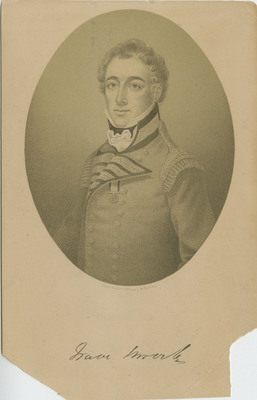
This small oval portrait of Isaac Brock is copyrighted 1896 by L.M. Taylor. Beneath the portrait is the name “Isaac Brock” handwritten in ink. The bottom left corner of the sheet is missing. Included with the portrait are two letters (dated 1896 and 1897) that make reference to the portrait.
-
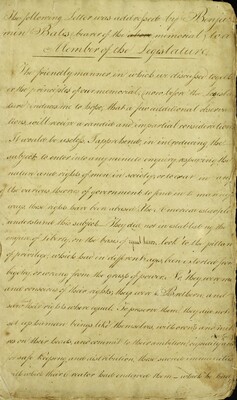
A 14-page manuscript with the caption title "The following Letter was addressed by Benjamin Bates (bearer of the memorial) to a Member of the Legislature". The letter is a personal appeal made to a specific member of the Virginia Legislature, asking that the Quakers be excluded from serving in the military or paying a penalty. The letter often accompanied a Memorial and Petition of the Religious Society of Friends (commonly called Quakers) submitted to the Virginia Legislature, asking that they be exempted from military service or from paying a penalty for refusal to serve in the military, on the grounds that it conflicted with their pacifist religious beliefs. This was during the outset of the War of 1812 in the United States, where the failure of a national military draft prompted several states to recruit independently. Both documents were published in the Georgetown newspaper the Federal Republican on May 31, 1813.
-
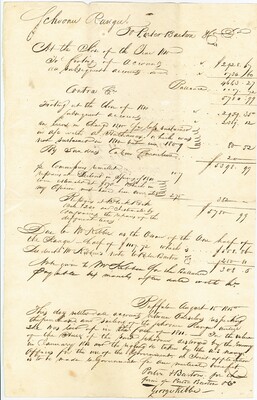
A page of entries detailing the financial history of the Schooner Ranger, a Great Lakes cargo ship, from 1810-1815. The ship sustained damage in 1811 on its journey from Detroit to Black Rock, in which 3 people drowned. The ship was subsequently “destroyed by the enemy in January 1813”. In August 1815, the ship’s account was settled. The settlement acknowledged that the ship was “taken by the U.S. Navy Officers for the use of the Government”, and is signed by Porter, Barton & Co., and George Kibbe.
-
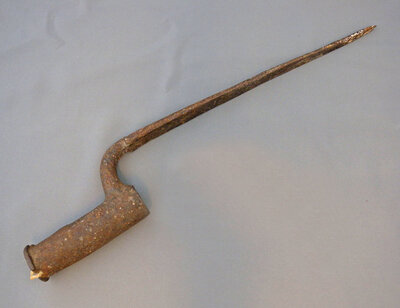
Brown Bess socket mount bayonet
-
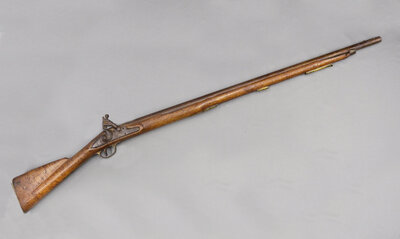
A brown bess musket
-
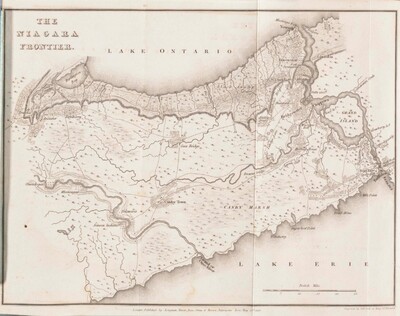
A map of the Niagara Frontier from Travels in Canada and the United States
in 1816 and 1817 by Lieut. Francis Hall, 14th Light Dragoons, dated May 20,
1818. It depicts the Niagara Peninsula with communities, roads, creeks, some topography features, and forts used during the War of 1812, including Fort Mississauga, Fort Niagara, Fort George, Fort Drummond and Fort Erie. Some
battle sites of the war are noted on the map, including Lundy’s Lane, Queenston, Chippawa, and Beaver Dams. The map was published by
Longman, Hurst, Rees, Orme, & Brown and engraved by Sidney Hall. Colour has been added to some portions of the map.
-

Half-penny token commemorating Sir Isaac Brock, ca. 1816. The token was struck for general circulation in Upper Canada. The name Brock is misspelled “Brook” on this token. The other side bears a picture of a sailing vessel and the
motto “Success to the commerce of Upper Canada”.
-
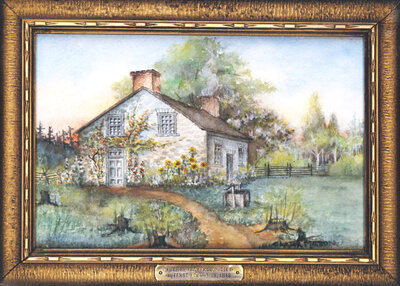
A painting by Clara Mason of the House where General Brock died in Queenston, October 13, 1812
-
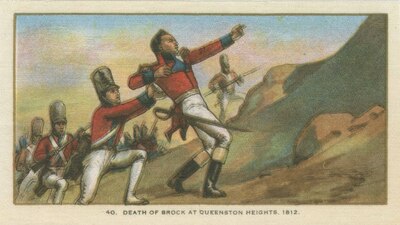
1 piece of silk which is imprinted with the death of Brock at Queenston Heights in 1812. This was part of the “Canadian History Series” of silks put out by the Imperial Tobacco Company. The item is printed with “40. Death of Brock at Queenston Heights, 1812.”
-
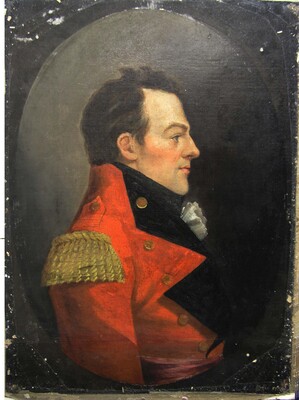
This work is a copy of a pastel oval portrait of General Brock that is supposedly the only known portrait of Brock to be done in his lifetime. The original was by William Berczy, circa1808, and is in the possession of Captain M.H.T Mellish, a descendant of one of Brock’s sisters. The canvas was previously mounted on a surface that was not acid free, and 4 holes are present from a previous frame.
-
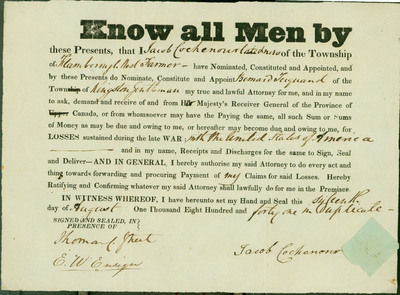
A War Loss Claim signed by Jacob Cochenour of the Township of Flamborough West. The claim is dated August 16, 1841.
-

The Statutes of his Majesty's Province of Upper Canada in North America outlining the recruitment, administration and discipline of the militia.
-
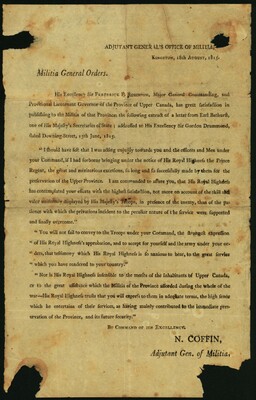
Militia General Orders from the Adjutant General’s Office of Militia, Kingston, 18 August, 1815. Consists of 4 paragraphs of a letter from Earl Bathurst to Sir Gordon Drummond, published by Frederick Robinson. The letter expresses thanks to Drummond and his troops for “the great service which you have rendered to your country”. The last few lines read “By Command of His Excellency, N. Coffin, Adjutant Gen. of Militia.”
-
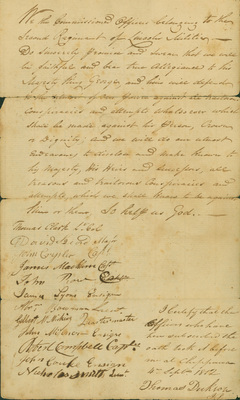
An oath of allegiance to King George III of England by members of the Second Regiment of the Lincoln Militia on 4 September 1812. These soldiers were sworn in by Justice of the Peace Thomas Dickson. The oath was signed by 12 men. The names are Thomas Clark, David Secord, John Crysler, James Macklem, John [Ross], James Lyons, [Abraham] Bowman, Gilbert McMicking, John Misener, Robert Campbell, John [Couke] and Nicholas Smith.
-
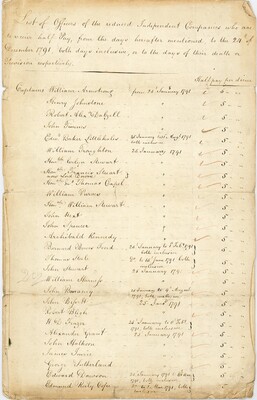
A List of Officers of the reduced Independent Companies who are to receive half pay from the days hereafter mentioned, to the 24th of December 1791, both days inclusive, or to the days of their death or Provision respectively. The document includes 153 names of Captains, Lieutenants, and Ensigns. Among the names are Isaac Brock and his brother Irwin Brock. It is signed by George Yonge.
-
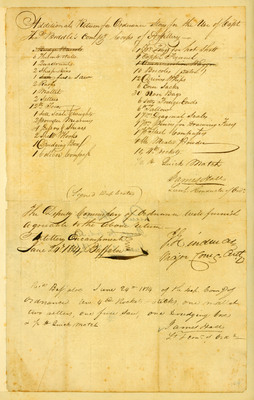
A return for ordnance stores for Captain Thos. Biddle’s company corps of artillery. The document is dated June 24, 1814 at the Artillery Encampment, Buffalo, and is signed by James Hall, Lieut. & Conductor of Ord., and J. Hindman, Major Coms. Arty. Some of the supplies listed include 1 quadrant, 2 sheepskins, 2 powder measures, 2 shell hooks, 1 caliber compass, 1 pr. Gongs for hot shott, 12 drivers whips, 6 lb. tallow, 10 4 lb. rockets, and ½ foot quick match. These supplies were likely used in the defense of Fort Erie in August 1814, when the fort was attacked by the British following the Battle at Lundy's Lane on July 25, 1814.
-
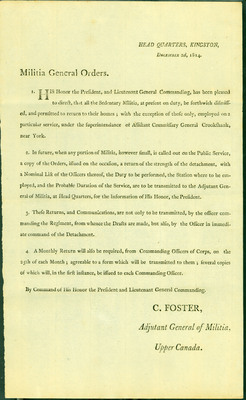
Militia General Orders dated December 2, 1814, disbanding the militia at the conclusion of the War of 1812. The orders were authorized by C.Foster, Adjutant General of Militia, Upper Canada.
-
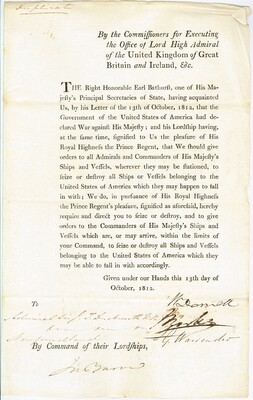
Admiralty Commissioner’s Orders sent to Admiral Sir John Thomas Duckworth, Governor and Commander-in-Chief of Newfoundland, informing him of America’s declaration of war against Great Britain and instructing him to seize and destroy all ships belonging to the United States of America which he may encounter. The document is dated October 13, 1812, and is signed by William Domett, Joseph Sydney Yorke, George Warrender, and John Barrow. The paper is marked “duplicate”. It is likely that several copies were issued and sent via different ships to ensure that at least one made it to Admiral Duckworth.
-
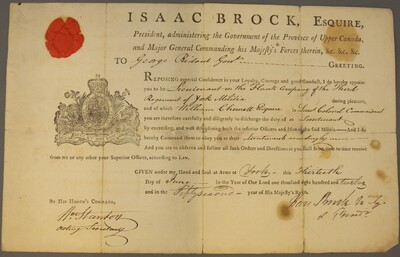
This is the official appointment of George Ridout to the rank of Lieutenant in the Flank Company of the Third Regiment of the York Militia, 1812.
-
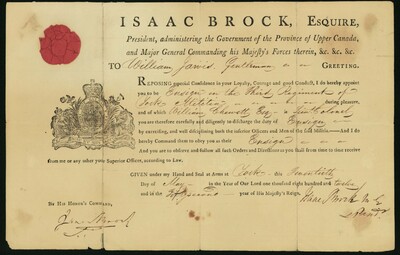
Appointment of William Jarvis, by Isaac Brock, Esquire, President, administering the Government of the Province of Upper Canada, and Major General Commanding His Majesty’s Forces therein, to Ensign in the Third Regiment of York Militia during pleasure and of which William Chewett, Esq. is Lieut. Colonel, dated at York 20 May 1812. Signed by James Brock and Isaac Brock.
-
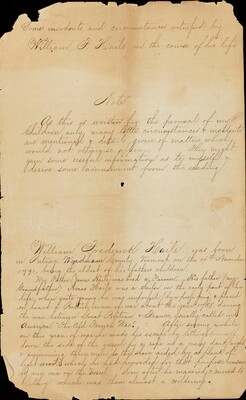
Memoir written by William Frederick Haile about his life, in particular, his experiences in the War of 1812.
-
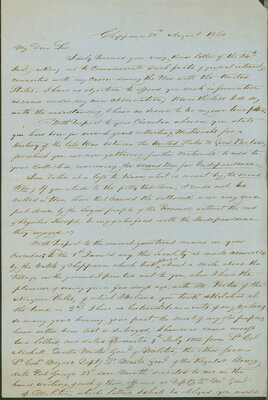
A letter written by Cummings, a Captain in the War of 1812. The letter discusses his military career during the War of 1812. He makes reference to
several battles he participated in, including Stony Creek, Beaver Dams, Black Rock, Chippawa, Cooks Mills and Lundy’s Lane.
-
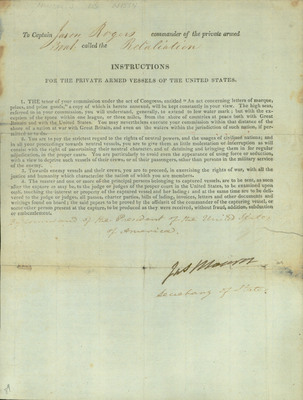
A letter of marque addressed to Captain James Rogers, commander of the boat Retaliation, and signed by James Monroe, secretary of state. Letters of marquee provided legal authority for an armed vessel to capture enemy ships and commit acts which would otherwise constitute piracy. The letter has no date, but was likely created during the War of 1812, and authorizes the Captain to attack and capture enemy vessels.
-
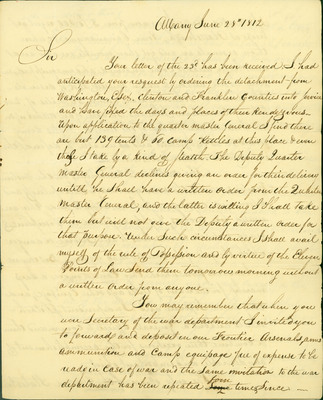
A letter written by Daniel D. Tompkins in response to a letter he received from Major General Dearborn. The letter is dated June 28, 1812 and describes the great need for arms and supplies for the American militia.
-
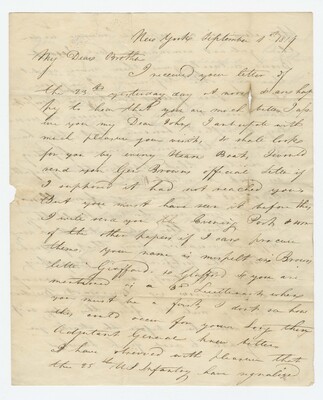
A letter from Arthur Gifford to his brother John Gifford. This letter discusses the British invasion of Washington. The transcription is included.
























